Exploring at Berkeley
Syllabus2004 attendees take their quest for knowledge to UC-Berkeley, one
of the world’s leading academic institutions.
Since 1868, UC-Berkeley has attracted visitors and students worldwide to the
central campus of the University of California, nestled among 178 acres of majestic,
wooded Northern California beauty. What better setting for a day of learning
and exploration as attendees walk the campus and partake of vigorous on-site
sessions and stimulating discussion groups? Syllabus2004 at Berkeley allowed
attendees to see and experience the latest education technology in action with
leading scholars and technologists.
| The Berkeley campus is renowned for its libraries, labs, research and
publications, and the distinction of its faculty and students. The faculty
includes eight Nobel Laureates, 124 members of the National Academy of Sciences,
19 MacArthur Fellows, 81 Fulbright Scholars, three Pulitzer Prize winners
and more Guggenheim Fellows (138) than any other university in the US. |
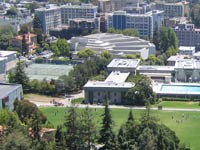 |
 |
Conference attendees journey on one of the nine buses that ferried them
from the Hyatt Regency in San Francisco to the UC-Berkeley campus. |
| Berkeley is known for its architectural and historical landmarks, such
as Wheeler Hall and the soaring Campanile (Sather Tower). |
 |
| Opening keynote. Clifford Lynch, executive director of the Coalition for
Networked Information (CNI), and adjunct professor at UC-Berkeley, delivers
the opening keynote address, “Digital Learning Cultures,” at
the Hyatt Regency; the conference moves to the UC-Berkeley campus immediately
afterward. |
 |
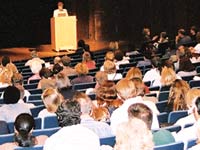 |
Berkeley welcome address. Christina Maslach, vice provost of Undergraduate
Education at UC-Berkeley, welcomes the Syllabus2004 attendees. |
| Berkeley overview and keynote. Kristine Hafner, UC’s associate VP
of Information Resources, Office of the President, delivers the Berkeley
keynote, detailing IT’s role in the university system’s financial
and strategic picture. |
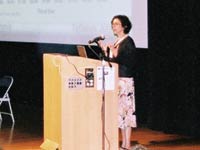 |
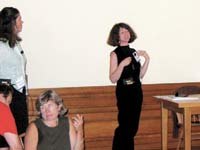 |
On-site sessions. Karen Miles (left) and Judy Stern (right), Berkeley
Educational Services instructional technology specialists in Multimedia
Authoring and Faculty Training, share their experiences with attendees in
“Technology Training for Faculty: Meeting Diverse Needs,” in
the Maude Fife room at Stephens Hall, below |
| Hitting the trail. Attendees put on their walking sh'es as they move from
session to session around the UC Berkeley campus. |
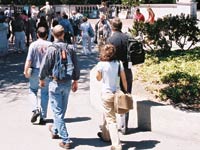 |